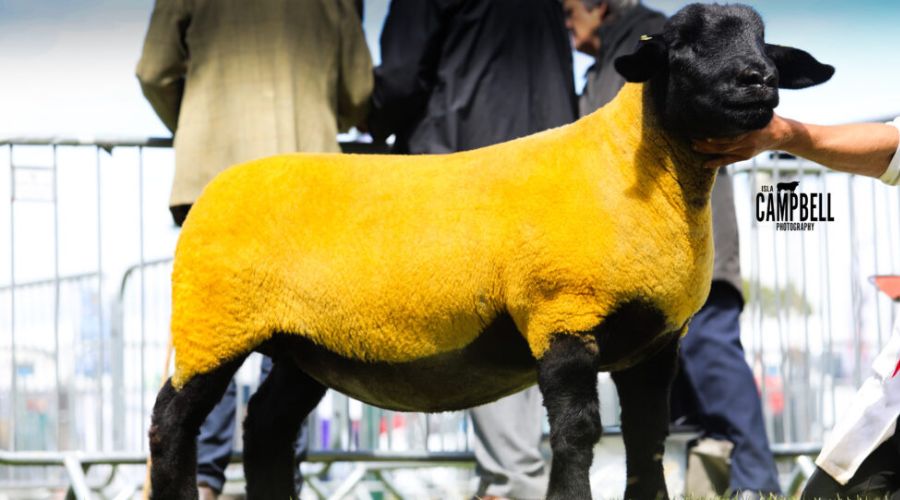Celebrating Suffolks: An ancient but adaptable breed
10th July 2024
The Suffolk sheep, which dates back to the 1700s, is well adapted for the modern climate and consumer demands, according to the Suffolk Sheep Society.

Despite being one of our oldest British breeds, and originally being renowned for its mutton, the Suffolk sheep has evolved to suit modern tastes and conditions.
The breed is “number one” for growth rates, meaning reduced input costs, and it is not adversely affected by hot weather, according to the Suffolk Sheep Society.
It is now found throughout the world’s sheep producing countries and is the leading terminal sire in the UK and Ireland.
A brief history
Originating from the Bury St Edmunds area, Suffolks are the result of mating Norfolk horn ewes with Southdown rams.
The breed was known as the Southdown Norfolk or, more locally, as ‘black faces’.
In 1797, Arthur Young is recorded as saying the breed should be called the Suffolk breed, and noted the mutton has ‘superior texture, flavour, quantity and colour of gravy’.
The Suffolk Show exhibited the first classes of Suffolk sheep in 1859.

READ MORE: Jacob sheep: Distinctive, hardy and good tempered
Suffolks developed around the rotational system of farming in East Anglia, grazing on grass or clover in the summer.
After weaning, the ewes could be put on salt marshes or stubbles. Swedes, turnips or mangels were grazed in the winter in a very labour-intensive system, with a fresh area fenced off each day.
Lambing was in February or March, outdoors in the fields with a hurdle shelter or in open yards surrounded by hurdles and straw.
The breed expanded rapidly, with the first flock in Ireland established in 1891, in 1895 in Scotland and 1901 in Wales.
From the earliest days sheep were exported around the world.
READ MORE: On a mission to save the Babydoll sheep breed
Benefits of Suffolk sheep
High growth rates: Numerous independent scientific studies show the Suffolk is “number one” for growth rates, the Society points out.
This means Suffolk lambs are ready for market earlier, resulting in reduced input costs. They can also be taken to heavier carcase weights, if required.
Countering common problems: The breed has high milk output, hard hooves and wide pelvic dimensions for easy lambing.
This means introducing Suffolk genetics to a commercial ewe flock is an excellent counter to problems such as soft and/or slow growing lambs, or ewes with unacceptable levels of udder and feet problems.
A changing climate: Commercial farmers are becoming more reliant on Suffolk rams, as many other breeds struggle to perform in hot weather.

This breed can deliver in a range of environments and isn’t adversely affected by hot summers and the associated respiratory problems seen in some breeds.
Maternal: Traditionally a terminal sire, more and more farmers are also using Suffolks for their maternal qualities.
Excellent flavour: Suffolks produce an excellent early lamb with great muscling and marbling to deliver the taste, flavour and texture demanded by today’s consumer, the Society says.
READ MORE: Exmoor Horn: Dual-purpose breed offers value as farming policy shifts
Low input and healthy
Suffolk sheep keepers rate the breed’s ability to thrive in low-input systems, and to produce consistent, vigorous lambs.
David and Isobel McAlpine, who have farmed at Mayfield for 50 years, have said their Suffolk x sheep are “healthy with a low level of feet problems” and ewes have “longevity of breeding with low depreciation.”
“The Suffolk female out of the mule ewe is an excellent early maturing female providing traits of growth rate, fleshing, milking ability and the ability to feed lambs from grass with minimal use of concentrates which is exactly what we require in a commercial female,” David noted.
“[…] The Suffolk ram provides us with high growth rates and lambs that can finish fast from our grass leys,” he added.
Suffolk genetics have also been key to the success of the large sheep enterprise at Godolphin Newmarket.
Shepherd Andy Armer has previously said the Suffolk x ewes are excellent, prolific mothers that milk well, and produce good quality, fast growing prime lambs when put to the Charollais ram.
The light low-lying ground means lambs need to be sold as quickly as possible to take pressure off grazing in the summer months.
The Suffolk x ewe’s feed efficiency has been key to the management of the flock.
Andy also said their Suffolk rams had good feet and longevity, keeping replacement costs low.

The breed society
The Suffolk Sheep Society was formed in Stowmarket in 1886.
Its aim was, and remains, primarily to “advance and promote agriculture by improving the breed of Suffolk sheep” and to “promote improvement of the breed of Suffolk sheep”.
The Society has also introduced NextGen – Succession for Suffolks.
If you are under 26 years old and have at least two registered pedigree Suffolk ewes, you can apply to become a NextGen member of the Society.
For more information on the breed, shows, and NextGen, visit the Society’s website.
Read more sheep news.




